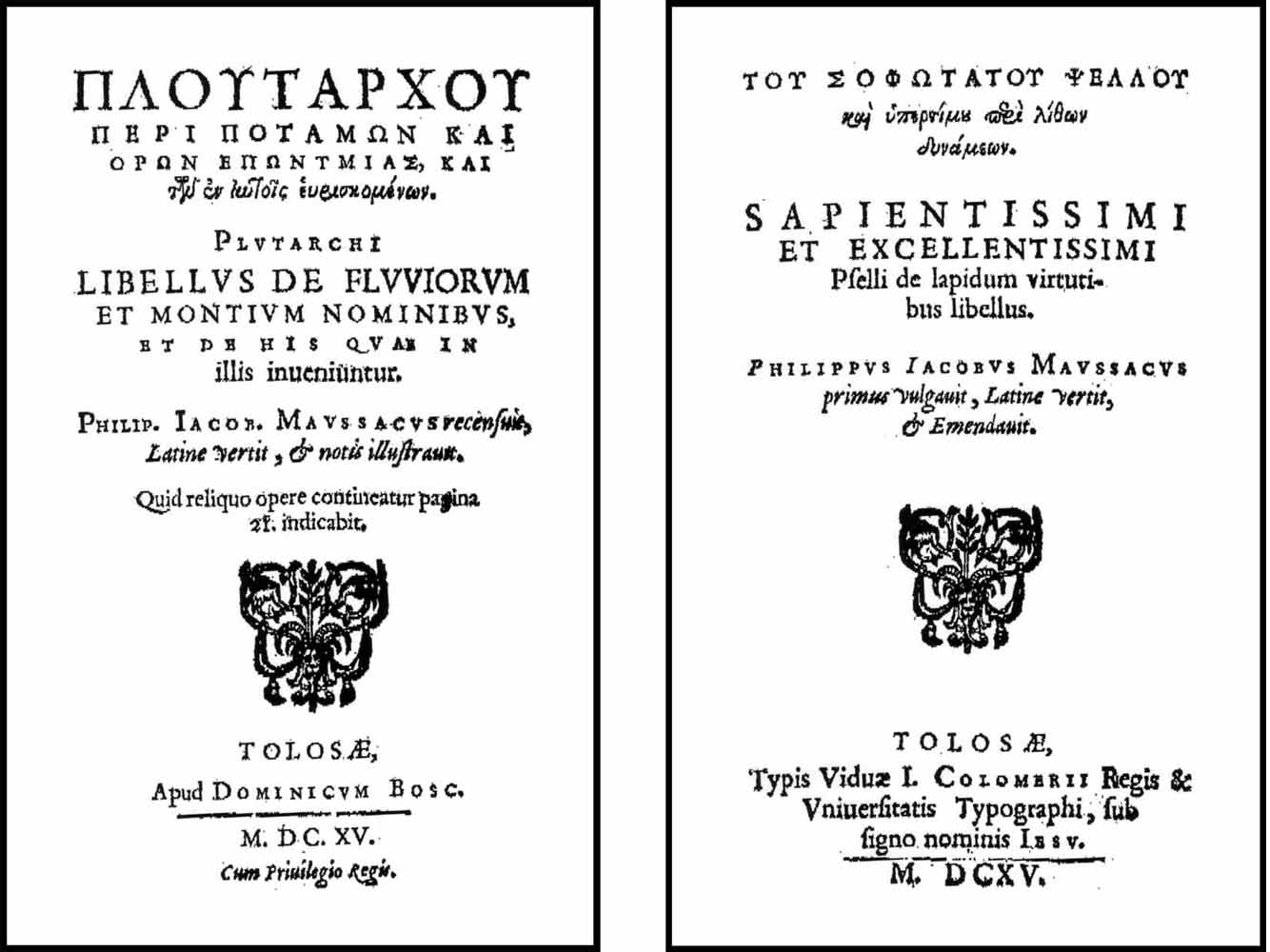PLUTARCH.
(0048? – 0122?)
Plutarch spend time in Rome and other places in the Roman empire, but returned to his birth city. He is particularly remembered for his Lives that gives biographies of the famous people of his era. However he authored about 80 other essays collected in his Moralia. A number of other works on a wide range of subjects are also attributed to his name but they are probably not genuine.
Biographical references: Sarton, Introduction, 1928-52: 1, 251-2. • Volkmann, R.v., Leben, Schriften und Philosophie des Plutarch von Chaeronea. Berlin, S. Calvary, 1869. 2 vols. [Reprinted, Hildesheim; New York, G. Olms, 1980.].
Supposititious Works

1. Latin, 1615 [First edition].
ΠΛΟΥΤΑΡΧΟΥ |
ΠΕΡΙ ΠΟΤΑΜΩΝ ΚΑΙ |
ΟΡΩΝ ΕΠΩΝΤΜΙΑΣ, ΚΑΙ |
[...one line of text in Greek...] | Plvtarchi | Libellvs De Flvviorvm | Et Montivm Nominibvs, | Et De His Qvam In | illis inueniuntur. | Philip. Iacob. Mavssacvs recensuit, | Latine vertit, & notis illustravit. | Quid reliquo opere contineatur pagina | 2f. indicabit. | [ornament] | Tolosæ, | Apud Dominicvm Bosc. | [rule] | M. DC. XV. | Cum Priuilegio Regis.
ΤΟΥ ΣΟΦΩΤΑΤΟΥ ΨΕΛΛΟΥ | [...2 lines in Greek...] | Sapientissimi | Et Excellentissimi | Pselli de lapidum virtuti- | bus libellus. | Philippvs Iacobvs Mavssacvs | primus vulgauit, Latine vertit, | & Emendauit. | [ornament] | Tolosæ, | Typis Viduæ I. Colomerii Regis & | Vniuersitatis Typographi, sub | signo nominis Iesv. | [rule] | M. DCXV.
8°: [8], 376 p.; [4], 60 p.
Very rare. A significant volume, published with comments by the Languedocian scholar Philippe Jacques de Maussac [1590-1650]. It brings together three scientific and esoteric works for the first time: 1) De Fluviorum et Montium Nominbus of Plutarch which is here printed in its first Latin translation prepared by Philippe Jacques de Maussac. 2) De Lapidum Virtutibus of the mathematician and philosopher of Constantinople, Michael Psellus [1020-1110], appears here for the first time in a treatise on mineralogy and hermetism. It is accompanied by the Latin translation also given by Maussac and which appears here also in its first edition. 3) Microcosmus seu Liber Cephale Anatomicus de Proportione Utriusque Mundi by the doctor of Nimes Jean Pistorius and had been published previously in Lyon in 1606. It is a curious and esoteric treatise which puts in parallel mankind and the Universe. The compilation volume is seldom complete. Brunet describes it with the following comment: "Not a common edition. There are examples with a general title announcing the treatise De Microcosmo of J. Pistorius but with the treatise not present."
The first of these works, that entitled De Fluviorum et Montium (Treatise on Rivers and Mountains), has been attributed to Plutarch, who was born about 46 C.E. and died at a very advanced age, although the exact date of his death is not known. It is included in some editions of Plutarch's collected works, and omitted in others. Iit is now generally agreed that the treatise was not written by him but by some unknown author who is generally referred to as either "pseudo-Plutarch" or "α-Plutarch," and that it dates from the first quarter of the third century. It is a strange work and at first glance the reader is at a loss to know whether he has before him a treatise on geography or one on religion. Further examination, however, shows it to be a magical and medical treatise, resembling the Kyranides in many respects, and like these it is divided into twenty-four chapters, the number corresponding to that of the letters in the Greek alphabet. There are twenty-four stones mentioned in this Treatise, some of them, as for example beryl, asterites and sardonyx, being well known, others are well-known stones which here appear under new names.
Contents of the volume are the α-Plutarch's Libellvs de Flvviorvm dt Montivm (pp. 1-96), followed by the Liber De Fluminibus of Vibio Sequestre (pp. 97-126) and notes and commentary to both (pp. 127-333). This work contains the first appearance of the Libellus de Lapidum virtutibus of Michele Psello, which is fully described under that author. After a separate title page, introductory material by Gilberto Gualmino (pp. 337-343) begins the Psello text, which has been edited and translated by Philippe Jacob de Maussac. This text appears on pages 345-357, set in two columns, with the Greek (on the left) and Latin (to right). The Psellos work is then followed by the Castigationes (pp. 358-361), and an appendix with notes by Arpocrazione (pp. 361-375). The De Microcosmo of J. Pistorius that sometimes accompany the book, but which is not always present, has a separate title page and pagination of 60 pages.
Bibliographical references: Adams, Birth and Development, 1938: p. 28, 30-2. • BL [686.b.14.(1.)]. • Brunet, G., France Litteraire au XVe siecle. Paris, 1865: 4, p. 747-748. • Gatterer, Mineralogischen Literatur, 1798-9: 2, 7. • Hoffmann, Lexicon Litteratur Griechen, 1838-45: 3, p. 303-304. • LKG: III 41*. • Mély, Les Lapidaires Grecs, 1898-1902: p. liv. • Mottana, Annibale., "Storia della mineralogia antica. I. La mineralogia a bisanzio nel XI secolo D.C.: I poteri insiti nelle pietre secondo Michele Psello," Ren. Fis. Acc. Lincei, Ser. 9, 16 (2005), 227-295. [A detailed history of Michelle Psello's lapidary of the eleventh century.] [title page figured].
2. Greek & Latin, 1618 [Another edition].
ΠΛΟΥΤΑΡΧΟΥ
ΠΕΡΙ ΠΟΤΑΜΩΝ ΚΑΙ
ΟΡΩΝ ΕΠΩΝΤΜΙΑΣ, ΚΑΙ. Plutarchi Libellus de fluviorum et montium nominibus ... P. J. Maussacus recensuit, Latine vertit, et notis illustravit. (Vibii Sequestri liber de fluminibus, fontibus ..., gentibus quorum apud poetas mentio fit.
ΤΟΥ ΤΟΥ ΣΟΦΩΤΑΤΟΥ ΨΕΛΛΟΥ. Pselli Libellus de Lapidum Virtutibus, Phil. Jac. Maussacus primus Vulgavit, Latine Vertit et Emendavit; Græce et Latine. Tolbsæ, Dominique Bosc, 1618.
8°: [8], 376 p.; [4], 60 p. Very rare.
Bibliographical references: BL [569.c.10.(1-3.)].
.